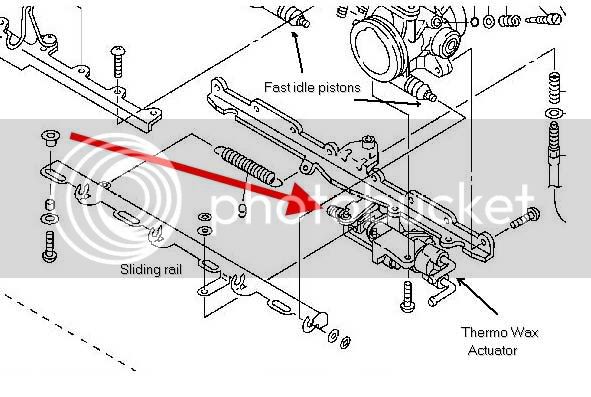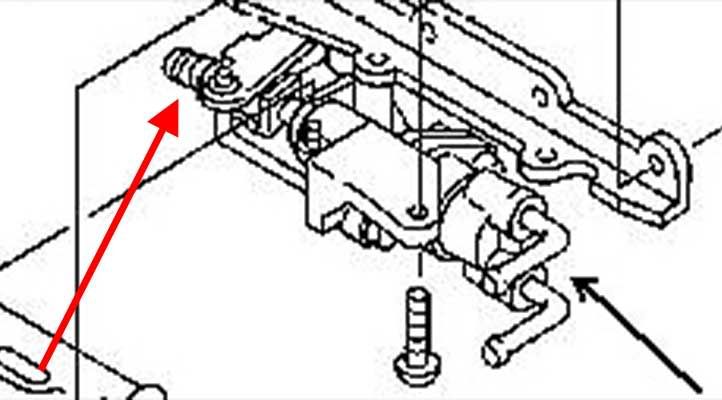Metric
Well-known member
Well I finally made time to come back to this project and see what I could figure out. I am a little surprised as to how backing out the TB adjustment screws so much really didn't make the readings to far off of what the manual says everything should be at.
Ok, to start off my idle adjustment screw was all the way in and the bike would idle right at 1k, probably just a touch under. With my mercury gauge hooked up and the bike warmed up and idling at 1kish, all four cylinders showed approximately 24 cmHg (the manual says 33.3 kPg or 250 mmHg, for this write up I will be using cmHg because that is what my gauge reads in).
The first thing I did was turn the #3 TB adjustment screw two good turns out. The mercury dropped to 20.5 cmHg. Since I was already on the right side of the bike I also adjusted #4 down to match. Upon moving #4 the idle came up on the bike. At this point I have two cylinders showing much less vacuum then the manual specifies. I was starting to think that I was going to be way off from were I should be once I got done with this experiment. I went ahead and adjusted 1 and 2 to match 3 and 4. At this point the tach is showing about 1200 rpm.
Now I adjust the idle back a touch to what I think is 1100 rpm......look down at the mercury gauge and what do you know, I'm reading right at 24 cmHg again on all the cylinders! Great! I decided that since this was working out well so far I was going to back out the TB adj. screws some more. Basically I wanted to be able to make 1100 rpm the center of my idle adjustment range since I felt that was were I wanted my bike to be at to hopefully minimize the issues coming off of high idle in as the bike warms in the mornings. After I went through the whole process one more time I did get the rpms to rise a little more.
As of right now, I read 24 cmHg on all four cylinders and I can now adjust my idle from about 1600-1650 to 800 rpm, so a much better range. Originally my TB adj. screws were almost all the way down. If you look at them now, the heads of the screws are close to level with the opening surface. I have never had the bike adjusted by a shop, so I assume that #3 was that way from Yamaha (+ or - any movement over time).
So, in my particular case I believed that if I could get another 100 rpm of idle speed, my bike would be ok. Since the ECU recall the only issues I am having is when the bike comes off of high idle as it warms in the mornings. After my tune up at the first of the month I got it past actually stalling during that time and to the point that is just almost stalls. Tomorrow morning might not be the best morning to tell if the touch of extra idle rpm makes this little hiccup in the ECU controls (thats what I'm blaming it all on since it wasn't there with the original ECU!) tolerable and hopefully fairly unnoticeable as the temps are not supposed to drop to much tonight (70's). However, it sounds like Friday morning will be cooler (low 60s maybe upper 50s that morning).
So Twistedcricket, I'll let you know if my bike is adjusted out in a couple of days. I would imagine that if this fixes mine, yours has got to be close since worldbound4now did the same stuff I just did. The only difference might possibly be how much he backed the TB adj screws out. What does your bike idle at when it shows four bars on the temp gauge?
Ok, to start off my idle adjustment screw was all the way in and the bike would idle right at 1k, probably just a touch under. With my mercury gauge hooked up and the bike warmed up and idling at 1kish, all four cylinders showed approximately 24 cmHg (the manual says 33.3 kPg or 250 mmHg, for this write up I will be using cmHg because that is what my gauge reads in).
The first thing I did was turn the #3 TB adjustment screw two good turns out. The mercury dropped to 20.5 cmHg. Since I was already on the right side of the bike I also adjusted #4 down to match. Upon moving #4 the idle came up on the bike. At this point I have two cylinders showing much less vacuum then the manual specifies. I was starting to think that I was going to be way off from were I should be once I got done with this experiment. I went ahead and adjusted 1 and 2 to match 3 and 4. At this point the tach is showing about 1200 rpm.
Now I adjust the idle back a touch to what I think is 1100 rpm......look down at the mercury gauge and what do you know, I'm reading right at 24 cmHg again on all the cylinders! Great! I decided that since this was working out well so far I was going to back out the TB adj. screws some more. Basically I wanted to be able to make 1100 rpm the center of my idle adjustment range since I felt that was were I wanted my bike to be at to hopefully minimize the issues coming off of high idle in as the bike warms in the mornings. After I went through the whole process one more time I did get the rpms to rise a little more.
As of right now, I read 24 cmHg on all four cylinders and I can now adjust my idle from about 1600-1650 to 800 rpm, so a much better range. Originally my TB adj. screws were almost all the way down. If you look at them now, the heads of the screws are close to level with the opening surface. I have never had the bike adjusted by a shop, so I assume that #3 was that way from Yamaha (+ or - any movement over time).
So, in my particular case I believed that if I could get another 100 rpm of idle speed, my bike would be ok. Since the ECU recall the only issues I am having is when the bike comes off of high idle as it warms in the mornings. After my tune up at the first of the month I got it past actually stalling during that time and to the point that is just almost stalls. Tomorrow morning might not be the best morning to tell if the touch of extra idle rpm makes this little hiccup in the ECU controls (thats what I'm blaming it all on since it wasn't there with the original ECU!) tolerable and hopefully fairly unnoticeable as the temps are not supposed to drop to much tonight (70's). However, it sounds like Friday morning will be cooler (low 60s maybe upper 50s that morning).
So Twistedcricket, I'll let you know if my bike is adjusted out in a couple of days. I would imagine that if this fixes mine, yours has got to be close since worldbound4now did the same stuff I just did. The only difference might possibly be how much he backed the TB adj screws out. What does your bike idle at when it shows four bars on the temp gauge?
Last edited by a moderator:






















































